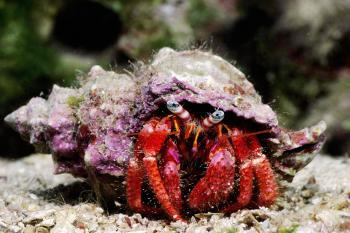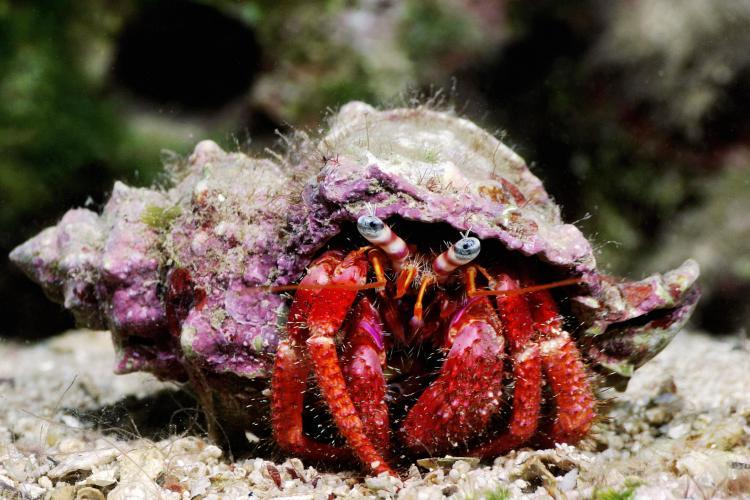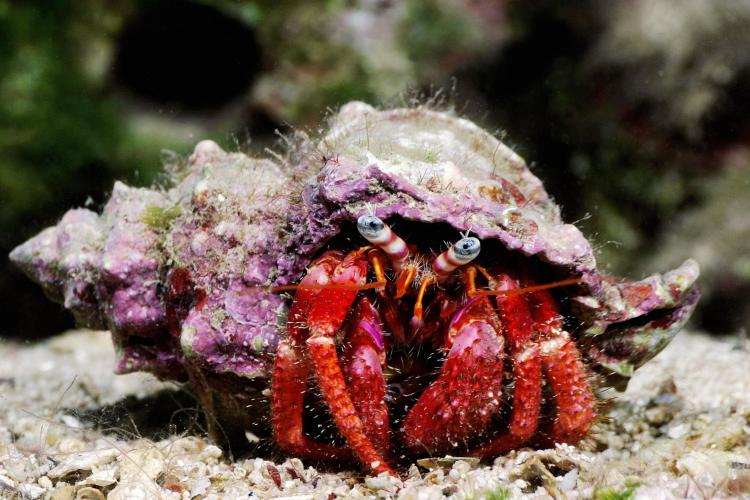Hermit crabs require empty snail shells for shelter. As they grow bigger, they need to find new shells to fit their increased size. Through field study, lab experiments, and computer modeling, scientists have found that in contrast to their names, hermit crabs usually find the best new shells when they gather together.
“Hermit crabs are really picky about real estate because they’re constantly getting thrown back into the housing market,” said lead researcher Dr. Randi Rotjan in a press release. Rotjan, a research scientist at the New England Aquarium, received her Ph.D. from Tufts University, where she conducted this study with Dr. Sara Lewis, a professor at Tufts University.
Often times, when hermit crabs fail to find suitable homes, they are naked and unprotected. Their soft abdomens make them vulnerable to predators.
“I’ve seen hermit crabs dragging around in bottle caps and even ballpoint pen tops. It’s pathetic,” Lewis said, according to the press release.
A previously identified strategy found among the crabs is the formation of a synchronous vacancy chain, a lively group activity. When a new shell becomes vacant, the group would gather around it and line up from largest to smallest. Once the largest crab moves into the empty shell, the other crabs move into a shell in front of them, consequently giving a new shell to each crab in the entire chain.
While observing the crabs during field study, the researchers discovered some behaviors unknown to the scientific world before. When hermit crabs find an empty but oversized shell, they wait nearby rather than just walk away.
“Some hermit crabs waited near the shell for periods up to 24 hours,” the researchers wrote in their paper.
Once a small group gathered, the crabs would begin piggybacking by holding onto the shell of a larger crab—such behavior seemed to increase the chance of a synchronous vacancy chain.
“It has been demonstrated that a single vacant shell can trigger a sequential chain of vacancies that effectively distributes resource benefits across many individuals,” the scientists wrote.
“They spend hours queuing up, and then the chain fires off in seconds, just like a line of dominoes,” added Rotjan.
According to Rotjan, the same kind of synchronous vacancy chain can happen with any animal that depends on isolated and reusable resources, including anemone-dwelling fish and hole-nesting woodpeckers.
Furthermore, the researchers suggested that hermit crabs’ participation in synchronous vacancy chains can also bring new understanding to human behavior. For instance, in Boston, Mass., apartment hunters carefully assess all the housing options beforehand and line up on September 1 to switch into their ideal homes—similar to how hermit crabs choose their shells and line up to fit into them.
Their research is published in the May/June 2010 issue of the journal Behavioral Ecology. To read the research paper, please visit http://beheco.oxfordjournals.org/cgi/content/full/21/3/639
See a video of a synchronous vacancy chain at http://www.youtube.com/watch?v=kcfDzvm3150
“Hermit crabs are really picky about real estate because they’re constantly getting thrown back into the housing market,” said lead researcher Dr. Randi Rotjan in a press release. Rotjan, a research scientist at the New England Aquarium, received her Ph.D. from Tufts University, where she conducted this study with Dr. Sara Lewis, a professor at Tufts University.
Often times, when hermit crabs fail to find suitable homes, they are naked and unprotected. Their soft abdomens make them vulnerable to predators.
“I’ve seen hermit crabs dragging around in bottle caps and even ballpoint pen tops. It’s pathetic,” Lewis said, according to the press release.
A previously identified strategy found among the crabs is the formation of a synchronous vacancy chain, a lively group activity. When a new shell becomes vacant, the group would gather around it and line up from largest to smallest. Once the largest crab moves into the empty shell, the other crabs move into a shell in front of them, consequently giving a new shell to each crab in the entire chain.
While observing the crabs during field study, the researchers discovered some behaviors unknown to the scientific world before. When hermit crabs find an empty but oversized shell, they wait nearby rather than just walk away.
“Some hermit crabs waited near the shell for periods up to 24 hours,” the researchers wrote in their paper.
Once a small group gathered, the crabs would begin piggybacking by holding onto the shell of a larger crab—such behavior seemed to increase the chance of a synchronous vacancy chain.
“It has been demonstrated that a single vacant shell can trigger a sequential chain of vacancies that effectively distributes resource benefits across many individuals,” the scientists wrote.
“They spend hours queuing up, and then the chain fires off in seconds, just like a line of dominoes,” added Rotjan.
According to Rotjan, the same kind of synchronous vacancy chain can happen with any animal that depends on isolated and reusable resources, including anemone-dwelling fish and hole-nesting woodpeckers.
Furthermore, the researchers suggested that hermit crabs’ participation in synchronous vacancy chains can also bring new understanding to human behavior. For instance, in Boston, Mass., apartment hunters carefully assess all the housing options beforehand and line up on September 1 to switch into their ideal homes—similar to how hermit crabs choose their shells and line up to fit into them.
Their research is published in the May/June 2010 issue of the journal Behavioral Ecology. To read the research paper, please visit http://beheco.oxfordjournals.org/cgi/content/full/21/3/639
See a video of a synchronous vacancy chain at http://www.youtube.com/watch?v=kcfDzvm3150







Friends Read Free